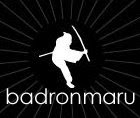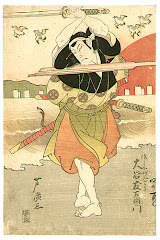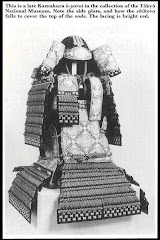
Parts of the bokuto
Here is a list of parts on the bokuto, they are the same as the names for the parts of a live blade.
Kissaki: the tip.
Mune: the back of the blade.
Monouchi: the cutting portion of the edge, the 1/3 closest to the kissaki.
Chu-o: the middle third of the blade.
Tsuba moto: the third of the blade closest the handle.
Tsuba: the guard, not present on most Aikido bokuto.
Tsuka: the handle.
Shinogi: the ridge between the mune and the edge.
Shinogi-ji: the flat plane between the mune and the shinogi
Jigane: the flat plane between the shinogi and the temper line (edge).
Ha: the edge
Tsuka gashira: strictly the pommel fitting, butt end of the bokuto.
Obtaining a bokuto
The wooden sword is usually made from oak, maple or hickory if it is to be used in partner practice. These woods have a high degree of strength and impact resistance. Maple and hickory are especially resistant to the splintering which may occur after repeated denting of the blade in the contact with another weapon. Other, more exotic woods, such as ebony, cocobolo or blackheart are sometimes used for their density, the greater weight more closely matching the metal katana. These woods are expensive and often contain flaws which make them less suitable to use in partner practice but ideal for individual training. While the weight of the bokuto may approach that of a katana, the balance is always different. The katana, due to its metal blade and wooden handle, has a balance point much further forward than that of a bokuto.
Specially shaped wooden swords called suburito are used to practice the individual cuts of a sword school. These weapons are designed to approximate the balance of a katana but are much different in shape and size. Often suburito of great weight are used to strengthen the arms and improve the posture.
Once a student has decided to study the bokuto the selection of a good weapon is of great importance. The suitability of a sword will determine to a large extent the ease with which a swordsman completes his practice. A student will own a bokuto for many years if it is chosen carefully and one should look for several characteristics when buying the weapon.
The shape and colour of the sword should be pleasing to the eye, the grip should feel smooth and free of stickiness which will cause blisters. The grip should also be large enough in the hand so that the fingers don't touch the palm. A badly sized handle can cause excessive cramping in the hands and a poor pattern of callous formation on the palm. The wood grain should be straight, with no knots and run from the handle to the tip. The growth rings should also run from the top of the sword to the edge. This pattern will give the strongest Bokuto possible. Look for a tight, closed grain which will resist denting. No warps or cracks should be seen. The wood should only be finished with tung oil or boiled linseed oil. Hard surface finishes such as varnish will cause the handle to be sticky. The weight of a Bokuto should be such as to allow the completion of a two hour practice which might include several thousand cuts. For this reason, students should consider beginning with a lighter sword and then moving to a heavier version when the arm and shoulder strength permits. A sword that is too heavy can cause muscle strain, and the slowness with which it must be moved can cause problems during partner practice.
Making a bokuto
With a few basic tools it is not hard to make a bokuto. The first consideration is which wood to use. The choice will depend on what style of sword is being made and whether or not it is to be used for partner practice. Once a source of suitable wood is found the actual piece must be chosen. Use a board that is about one inch thick and at least two inches wide for a bokuto. A suburito may require other dimensions. The grain must be straight and preferrably running along the wide dimension of the end of the board, rather than across it.
I'm going to describe how to use a lot of power tools to make your bokuto, you don't need all of these, so adjust the instructions according to what you have.
Much of the wood available these days is not fully dry. If it is practical, buy your wood and store it for several months to a year in conditions similar to your practice place. This will ensure that the wood is at a proper humidity level and any faults that are going to develop will do so before you start working.
The easiest way of laying out a pattern for the curve is to use a bokuto you have already decided you like. If you don't have a pattern then cut the board to about 41 inches long and at least two inches wide. Check the grain patterns and decide which end of the board is weakest, this is your handle. If the grain has a curve then the curve of the sword will follow it. Decide how far along the blade the bottom of the curve will be. For Bizen style blades the point of maximum curve is close to the handle, for other styles it is closer to the middle of the blade. Mark out a curve so that the bokuto is about one inch tall (from ha to mune). The top of the handle and the point will touch one side of the board. The point of maximum curve on the edge touches the other side if the board is 2" wide. Cut out this sword blank with a band saw or a sabre saw. I even used a 5 1/4 inch circular saw for a few blades when I had nothing else. The small blade will make this curve.
This is the time to decide what tip shape you desire, some sword styles leave the point blunt while others use a modified point. The commercial bokuto mimic the point of the katana. If you want a point cut the end at the angle preferred.
If your bokuto is going to taper toward the tip (it should to look good), and you have access to a jointer, mark the taper on the concave and convex sides and by using a series of longer and longer passes over the blades, create the taper on the sides of the blade. If you don't have a jointer you'll simply do this by hand when working on the shaping of the blade.
To carve out the shape some people prefer a wood rasp, some a plane. I prefer a combination of a spokeshave and a Stanley Surform depending on which wood I am using. I have a Workmate bench which is about the correct height for me to work on. Start with the blade section and do the handle last since the squared handle will allow you to keep the blade in the correct orientation while creating the long straight lines needed to produce a good looking bokuto.
Clamp the wood so that you can cut out the back ridge. For this you also need to have the blade clamped straight up and down. Hold the spokeshave at the chosen angle and use long smooth strokes to cut the shoulders. A 45 degree angle will make a round looking blade while an angle more toward vertical will create a thin blade. This is a matter of taste. When you have these shoulders cut to a straight pleasing line then you can start on the edge. Turn the blade over and work the curve into the bottom of the blade. A more rounded edge will create a heavier sword with a more resistant striking surface. A sharper edge, while weaker, will have a more pleasing shape. Make sure while you are working that the edge is lined up with the top of the blade. Clamping the squared handle will help with this. The edge will often wander as you cut so be careful. It is at this point that you determine the balance of the blade by how much you taper the blade toward the tip.
If you want to mimic the katana point use a Surform to cut a plane in from each side at the tip. If there is to be no point or a modified point then use the Surform to round off the edges of the tip and the base of the handle. Now is the time to even out any wavers in the lines along the back.
Clamp the blade carefully and cut out the handle. This is an important step since the handle is what you grip and it must agree with the curve of the blade. As a general rule the handle should be an oval shape with the long axis of the oval arranged so that you know where your blade edge is facing. In other words, the top and bottom of the oval must line up with the mune and ha.
If you have access to a fixed belt sander then use two hands to smooth off the wood. Your straight lines will become straighter at this point, and a lot of shaping can be done with a 36 grit belt. If the sander has a large flat bed you will have to create a padded "hump" on the bed with foam and masking tape so that the belt moves in a curve to fit the concave mune.
If you don't have a sander, you must work much more carefully with the hand tools unless you like blisters on your hands from the hand sanding. Use several grits of sandpaper to smooth the wood and close the pores. After sanding apply boiled linseed oil or Tung oil to finish it. Do not use surface finishes like varnish, urethane or danish wood oil. These will create a sticky surface that will give you blisters. An oil finish allows the wood to soak up the sweat on your hands while keeping the grain from lifting too much. If you use linseed oil make sure it is boiled, raw oil will never dry. I prefer tung oil.
If the blade feels good in your hands and is the right weight, the appearance is not important. This is a tool and it will soon be banged up so don't worry if it is not a museum piece.
The bokuto should be carried in a bag to protect it from sudden changes in temperature and humidity. The wood is not fully sealed by the oil finish so changes in the atmosphere may cause warping or checking. Never store the bokuto for a long period without support along the length, and keep it out of the sunlight. Treat it with the proper care and it will be useful for many years of hard service.










No comments:
Post a Comment